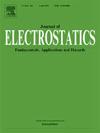Triboelectric properties on treated human hair: a mesoscale method to measure the surface potential
IF 2.1
4区 工程技术
Q3 ENGINEERING, ELECTRICAL & ELECTRONIC
引用次数: 0
Abstract
The anti-static effect is an increasingly valuable asset for hair treatment products, holding an increasing economic share. Hair care industries are increasingly looking for quantitative methods for hair treatment assessment, yet the multiscale nature of hair challenges the comparative assessment of its triboelectric properties. This study presents a straightforward methodology for measuring the surface potential of human hair at the mesoscale. Instead of studying microscale local charges highly accurately or bundling large bunches of hair for averaging, an intermediate approach was designed. The method was validated by varying both the hair count and the sample distance from the sensor. The results showed that the method can distinguish the surface charge of bleached hair from those of chemically untreated or mildly peptide treated. The variations in static charge were linked to the hair properties after the treatments, as assessed by Fourier transform infrared spectroscopy and scanning electron microscopy. The availability of a relatively simple technique to obtain quantified measurements of hair condition after treatment will enable hair care product manufacturers to identify potential defects, ensuring their products treat damaged hair to the required specifications and quality standards.
处理过的人类头发的摩擦电特性:测量表面电位的中尺度方法
防静电效果是美发产品越来越有价值的资产,占有越来越大的经济份额。护发行业正在越来越多地寻找定量方法来评估头发治疗,但头发的多尺度性质挑战了其摩擦电特性的比较评估。这项研究提出了一种在中尺度上测量人类头发表面电位的简单方法。设计了一种中间方法,代替了高精度地研究微尺度局部电荷或将大量毛发束成束进行平均的方法。通过改变毛发数和样品与传感器的距离来验证该方法。结果表明,该方法可以将漂白后的头发表面电荷与化学处理或轻度肽处理的头发表面电荷区分开来。根据傅里叶变换红外光谱和扫描电子显微镜的评估,静电电荷的变化与处理后头发的特性有关。一种相对简单的技术可以获得治疗后头发状况的量化测量,这将使护发产品制造商能够识别潜在的缺陷,确保他们的产品治疗受损的头发达到所需的规格和质量标准。
本文章由计算机程序翻译,如有差异,请以英文原文为准。
求助全文
约1分钟内获得全文
求助全文
来源期刊

Journal of Electrostatics
工程技术-工程:电子与电气
CiteScore
4.00
自引率
11.10%
发文量
81
审稿时长
49 days
期刊介绍:
The Journal of Electrostatics is the leading forum for publishing research findings that advance knowledge in the field of electrostatics. We invite submissions in the following areas:
Electrostatic charge separation processes.
Electrostatic manipulation of particles, droplets, and biological cells.
Electrostatically driven or controlled fluid flow.
Electrostatics in the gas phase.
 求助内容:
求助内容: 应助结果提醒方式:
应助结果提醒方式:


